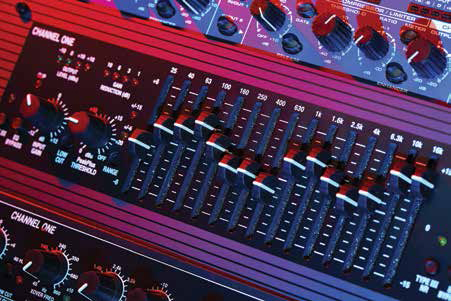
Smiley Face, Anyone?
Next up is poor system EQ; between it and distortion, we’ve identified 90 percent of the loudness problem. Again, and simply, if the mids and upper mids are too hot in the mix, it usually sounds “harsh.” Grating. Ear splitting. Hair parting. Paint peeling.
I think it’s possible that one reason for this is the prevalence of hearing loss among many sound engineers and techs, who then boost the mids and highs to compensate.
Another reason might be that we’re not walking the room and listening for hot spots. Perhaps at front of house, behind the desk, everything is perfect. But in some of the overlapping loudspeaker zones, maybe there’s HF buildup, maybe joined by some phase issues.
I also think it’s far too common to add mids and highs to individual channels to “bring them out” when it might be better to cut something else instead. This kind of boosting on several channels can very likely result in overloading hearing while not really bringing about the improvement in clarity we’re seeking. In the process, we might be pushing the master bus, a subgroup or a matrix channel over the edge, resulting in distortion.
Then there’s the famous (infamous?) “smiley face” graphic EQ curve we’ve all seen or maybe even used. Let’s let the amateur car stereo enthusiasts keep their smiley face curves, shall we?
An artistic tweak to the overall system EQ can work wonders, almost the same way mastering does for recordings. But it’s easy to overdo it and end up with a bunch of boomy bass and harsh, grating highs while also compromising clarity. Remember, cutting is almost always preferred to boosting.
Taste In Music?
One of the more subtle effects that causes some audiences to claim that sound is too loud has to do with their familiarity with the particular music being presented. Most of my years touring were with the U.S. Air Force jazz band, the Airmen of Note. It’s an 18-piece big band that performs traditional selections (Glenn Miller, Count Basie, etc.) as well as modern arrangements and compositions.
After years of touring with them, I came to the conclusion that if the music is familiar to the audience, no one thinks it’s too loud. Case in point: many of our concerts featured traditional style for the first half and modern style for the second half. I don’t recall a single complaint about the volume from anyone for a first half. In fact, after an hour of this music, people approached me at intermission asking why the band didn’t play one song or another. Some claimed it was “exactly like when I saw them in 1943 during the war.”
But when the exact same group, with the same PA and same FOH mixer in the same hall, played the second half, complaints were commonplace. The difference? You guessed it—the audience was unfamiliar with the material.
To come full circle, I think familiarity is a big reason why people like it loud when they go to rock concerts. They want to see their favorite artists playing their favorite hits, loudly and with a big PA that says “THIS IS A BIG ROCK CONCERT.” And there’s nothing wrong with that, as long as it’s also clean sound, well mixed.
Karl Winkler is director of business development at Lectrosonics and has worked in professional audio for more than 20 years.

